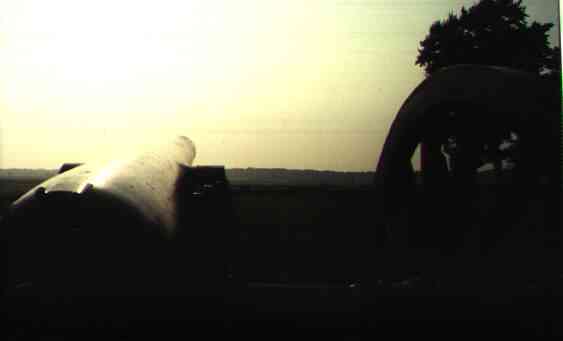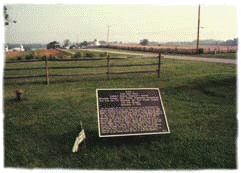

These are summaries of the battles. For first hand
news reports, note the dates and check our "From the Front" section for more
detail.
Marched in three days thirty miles. Sept. 16th, during the fore noon we lay in position a little to the right of Sharpsburg road and near Antietam River. In the afternoon Hooker’s Corps, consisting of Rickert’s, Meade’s and Doubleday’s divisions, cross to the south side of Antietam to attack and, it if possible turn the enemy’s left flank. The enemy were met and engaged by Gen. Meade’s Division and driven back, but darkness coming on we rest for the night on our arms. Distance three miles. Sept. 17 we are aroused at day break by sharp firing of the pickets on our left, and fall into line, advanced nearly parallel to the road leading into Sharpsburg in a cornfield near Dunkard Church.
C. Wheeler
The enemy evacuated his position on South Mountain the night of the 14, and on the 15th, McClellan’s army started in pursuit, coming up with him on the 16th, and finding him posted in a strong position, on Antietam creek near the village of Sharpsburg.
We continued march down the mountain through Boonsboro and then turning to the left followed the road towards Sharpsburg, finding several small bridges to which the enemy as he retired had said fire. In the course of a few miles, we reached the banks of Antietam creek on the other side of which the enemy had posted batteries and where some few bodies of his troops could be seen. The whole day was occupied in concentrating our troops here. general: McClellan with his staff reached the position during the afternoon and took a view of the ground from a hill behind where we were, while batteries exchanged some shots with each other.
We bivouacked for the night near the Sharpsburg turnpike remaining there until the afternoon of the next day 16th. Shells from the enemies guns every now and then passing over our heads. at length orders came in hooker with our corps, crossed the Antietam at a Ford near new Newkirch's and proceeded to take position on the extreme right. Whilst this was going on, Gen. McClellan made his at appearance on the field and was received with great enthusiasm by the troops. The enemies position was not developed until late in the afternoon when some fighting place between his advanced forces and are leading division mead's but darkness came on before the hold corps was and after receiving some of the enemies shelves, we bivouacked in the opened fields in want to the a very confused and huddled up condition, considering we were within range of the enemies artillery. Some firing occurred after night and General Hooker, whose headquarters were at a barn near the Puffenberger house close to the Hagerstown turnpike, remarked that enemy firing into his own troops as none of ours were in the direction of the firing. the next morning we needed no reveille, for at the earliest done firing commenced a and our troops were rapidly formed, the shelves commenting to scream over our heads. Whilst waiting for orders to move, a considerable skirmish was taking place on our left and front when an order came to me direct from General Hooker to move my brigade to the front and report to him.
The brigade was at once would in motion in McClellan of recommends closed in mass. the movement immediately attracted the attention of the enemies guns, posted on the opposite side of the Hagerstown Pike and their fire became quite rapid. As middle of the leading regimen the sixth Wisconsin and bursting, as it struck showing and wounding 20 to 30 men. Such a calamity is the severest test of discipline. For a few moments the column was checked as the poor suffering men were removed, and then at the voice of its Lt. Col., the Sixth moved on again, followed by the rest of the brigade. Reaching a strip of open once which extended from the Hagerstown Pike eastward that connecting what palfrey calls "campaigns of the civil war" roads, I found general hooker and Mead (the two future commanders of the army of the economic Potomac) in conference and received my orders. I was to advance directly to the front and attack.
Gen. John Gibbons
The forces of General McClellan were placed in front of the enemy’s position, on
the afternoon of the 16th, the First Corps, of General Hooker, upon the extreme right. The
Second Wisconsin was under the command of Lieutenant Colonel Allen, Colonel Fairchild
being sick; the Sixth under Lieutenant Colonel Bragg, and the Seventh under Captain
Callis. On the morning of the 17th of September, the Iron Brigade was detached from the
division, and sent up the Sharpsburg Turnpike, into a piece of woods, on the right of the
road. The brigade advanced along the turnpike until it reached an open space, when the
Sixth was deployed, and advanced to a cornfield in front, the Second deploying on its
left, and a section of artillery being placed in the rear, firing over the heads on the
men. The Second and Sixth pushed gallantly forward , supported by the Seventh, and
Nineteenth Indiana. The enemy attempted to outflank the Second and the Sixth but the
movement was frustrated by sending forward a section of Stewart’s Battery, (Battery
B) and deploying the Seventh, and the Nineteenth Indiana to the right of the line, into
the woods. The whole line was soon engaged. The enemy, being heavily reinforced, made a dash at the battery. They were successfully repulsed by heavy discharge of
canister from the guns, the fire of the few remaining men of the Second and Sixth
Wisconsin, and the flank fire poured in by the Seventh, and the Nineteenth Indiana, which
had been brought round to sweep the front of the battery. In this severe contest,
Lieutenant Colonel Bragg, of the Sixth, and Lieutenant Colonel Allen, on the Second, were
wounded and taken from the field, the former returning to the regiment after his wound was
dressed. Finding the guns almost deprived of support, and of cannoneers to work them,
General Gibbon ordered them to fall back, followed soon after by the infantry, much
reduced in numbers and short of ammunition.

A participant in the battle describes the fighting as much more severe than at Gainesville, on the 28th of August. In all his battles he had not seen the like. The battle of Gainesville was bad enough but Antietam seemed more horrible. After Lieutenant Colonel Allen was wounded, Captain Ely took command of the Second, and conducted it off the field, scarcely fifty men being left of the command. The Second went into action with 150 men, and lost 91.
In the early part of the action, a shell fell into the ranks of the Sixth, killing or wounding thirteen men and officers, among them Captain D. K. Noyes, of Company A. Captain E. A. Brown, of Company E, was killed in the action.
Private Robert Stevenson, of Company C, Second Wisconsin, who carried off the regimental flag, on the first Bull Run battlefield, and bore it on the 29th and 30th of August, 1862, on the same bloody field, sprang from his bed at the field hospital at Antietam, when he heard the skirmishing on the morning of the 17th, and pushed on alone to find his regiment. It was under fire - he reported himself to his Captain, saying:-"Captain, I am with you to the last;" and took the colors, which he held till he was shot down, pierced with seven bullets. Corporal Holloway was mortally wounded at the same time. When found, after the battle, their bodies were lying with their heads resting on their knapsacks.
The battle of Antietam has always been considered one of the bloodiest of the war. For the bravery and endurance shown by the Iron Brigade at this battle, General McClellan pronounced them equal to the best troops in the world! This was a great compliment from one who had seen the best armies of Europe.
After the battle, the Iron Brigade, on the 18th, moved across the battle field, and
camped near the Potomac, and engaged in burying the enemy’s dead, which had been left
on the field. The Twenty-fourth Michigan Regiment, was added to the Iron Brigade on the
10th of October.
Military History of Wisconsin, Quinter, 1866
Note: The Third Wisconsin, not part of the Iron Brigade, fought in this battle alongside the Brigade and suffered comparable losses. Speaking to how these units kept in action, later in the war, General W. T. Sherman observed "Wisconsin kept her regiments filled with recruits, whereas other States generally filled their quotas by new regiments, and the result was we estimated a Wisconsin regiment equal to an ordinary brigade - five hundred new men added to an old experienced regiment were more valuable than a thousand in the form of a new regiment." He was, of course, specifically referring to his Wisconsin regiments in the Army of the Tennessee but the general philosophy of replacements held - until the horrendous decimation of Gettysburg. Ed.
These are summaries of the battles. For first hand news reports, note the dates and check our "From the Front" section for more detail.
Here the old Iron Brigade lost heavily. America’s bloodiest day. Remain on the battlefield and under arms all day Sept. 18th. Everything is quiet, thought the enemy appear in front. Details are sent out to bury the dead where it can be done without an exposure to the enemy’s pickets.
Sept. 19th, at an early hour, it is reported that the enemy have retreated across the Potomac. We march across the battlefield and camp near the Potomac a mile west of Sharpsburg. Distance 3 miles. For several days details are made to bury the enemy's dead, the work being decidedly unpleasant, the weather being very warm and decomposition had set in. September 29th we remain resting, recruiting and drilling for several weeks.